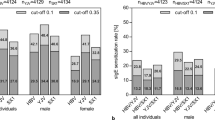Abstract
Pest-control operators represent a high occupational risk for Hymenoptera sting and a possibility of Hymenoptera allergic reactions, but the information is not well documented. A history of Hymenoptera stings was found in 118 (59.0%) of 200 Japanese pest-control operators. To evaluate the details of Hymenoptera stings and the factors associated with venom-specific IgE level which indicates Hymenoptera allergy, a questionnaire was administered and serum venom-specific IgE levels were measured in 105 subjects selected from 118 operators. The number of past stings was a mean of 3, and in most cases, they had been stung at only one site on the hand or the head and neck. Systemic reactions to Hymenoptera stings were also less frequent among them (5/105). Venom-specific IgE (to a yellow jacket, a wasp, and a honeybee) was measured by the CAP system, and it was found to be positive in 31.4% of the 105 subjects. The frequency of positive CAP was significantly associated with the following factors: the total serum IgE level (P<0.001), the time interval from the last sting-incident (P<0.001), the number of past stings (P<0.05), the most recent clinical symptoms (P<0.05), and an individual atopic history (P<0.05). Among these 5 factors, the former 4 factors were shown to influence the venom-specific IgE titer in the multiple-regression analysis using a forward-stepwise technique (multiple R=0.708, adjust R2=0.482, P<0.001). In particular, the influences of the total serum IgE level and the time interval were strong. These findings indicate that the frequency of Hymenoptera stings in pest-control operators is not as high as in beekeepers or forestry workers, and that venom-specific IgE is affected mainly by the total serum IgE level and the time interval from the last sting-incident.
Similar content being viewed by others
References
Ewan PW. Allergy to insect stings: a review. J. Royal. Soc. Med. 1985;78: 234–9.
Reisman RE. Insect stings. New Eng. J. Med. 1994;331: 523–7.
Muller U, Mosbech H. Position paper. Immunotherapy with Hymenoptera venoms. Allergy. 1993;48; 37–46.
Nakamura M. Suzumebachi no gyakushu. Tokyo: Shin-nihon shuppan; 1992:92–102. (Japanese)
Light WC, Reisman RE, Wypych JI, Arbesman CE. Clinical and immunological studies of beekeepers. Clin. Allergy. 1975;5: 389- 95.
Shimizu T, Hori T, Tokuyama K, Morikawa A, Kuroume T. Clinical and immunologic surveys of Hymenoptera hypersensitivity in Japanese forestry workers. Ann. Allergy Asthma Immunol. 1995;74: 495–500.
Yunginger JW, Jones R, Leiferman KM, et al. Immunological and biochemical studies in beekeepers and their family members. J Allergy Clin. Immunol. 1978;61: 93–101.
Annila IT, Karjalainen ES, Morsky P, Kuusisto PA. Clinical symptoms and immunologic reactivity to bee and wasp stings in beekeepers. Allergy. 1995;50: 568–74.
Bousquet J, Coulombm Y, Robinet-Levy M, Michel F-B. Clinical and immunological surveys in bee keepers. Clin. Allergy. 1982;12: 331–42.
Bousquet J, Menardo J-L, Aznar R, Robinet-Levy M, Michel F-B. Clinical and immunologic survey in beekeepers in relation to their sensitization. J. Allergy Clin. Immunol. 1984;73: 332–40.
Muller U, Speiss J, Roth A. Serological investigations in hymenoptera sting allergy: IgE and haemagglutinating antibodies against bee venom in patients with bee sting allergy, bee keepers and non-allergic blood donors. Clin. Allergy. 1977;7: 147–54.
Nordvall SL, Uhlin T, Einarsson R, Johansson SGO, Ohman S. Bee keepers’ IgG and IgE antibody responses to bee venom studied by means of crossed radioimmunoelectrophoresis. Clin. Allergy. 1984;14: 341–50.
Charpin D, Birnbaum J, Lanteaume A, Vervloet D. Prevalence of allergy to Hymenoptera stings in different samples of the general population. J. Allergy Clin. Immunol. 1992;90: 331–4.
Golden DBK, Marsh DG, Kagey-Sobotka A, et al. Epidemiology of insect venom sensitivity. JAMA. 1989;262: 240–4.
Stuckey M, Cobain T, Sears M, Cheney J, Dawkins R. Bee venom hypersensitivity in Busselton. Lancet. 1982;2: 41.
Herbert FA, Salkie ML. Sensitivity to Hymenoptera in adult males. Ann. Allergy. 1982;48; 12–3.
Jeep S, Kirchhof E, O’Connor A, Kunkel G. Comparison of the Phadebas RAST with the Pharmacia CAP system for insect venom. Allergy. 1992;47: 212–7.
Leimgruber A, Lantin J-P, Ftei PC. Comparison of two in vitro assays, RAST and CAP, when applied to the diagnosis of anaphylactic reactions to honeybee or yellow jacket venoms. Allergy. 1993;48: 415–20.
Settipane GA, Carlisle CC. A critical evaluation of RAST to venoms of Hymenoptera. Clinical Allergy. 1980;10: 667–73.
Clayton W, Georgitis JW, Reisman RE. Insect sting anaphylaxis in patients without detectable serum venom-specific IgE. Clin. Allergy. 1985;15: 329–33.
Savliwala MN, Reisman RE. Studies of the natural history of stinging-insect allergy: Long term follow-up of patients without immunotherapy. J. Allergy Clin. Immunol. 1987;80: 741–5.
Author information
Authors and Affiliations
Rights and permissions
About this article
Cite this article
Ono, T., Yoshida, M. & Nakazono, N. Hymenoptera stings and serum venom-specific IgE in Japanese Pest-control operators. Environ Health Prev Med 2, 172–176 (1998). https://doi.org/10.1007/BF02931697
Received:
Accepted:
Issue Date:
DOI: https://doi.org/10.1007/BF02931697




